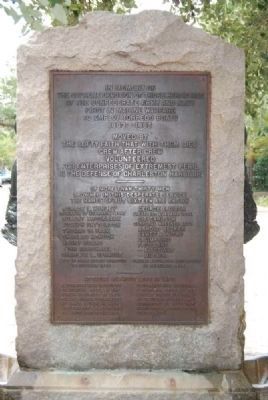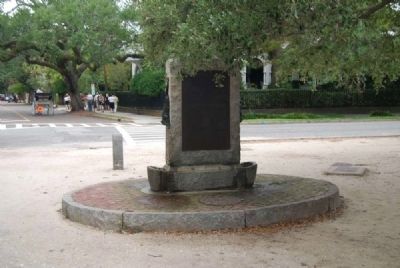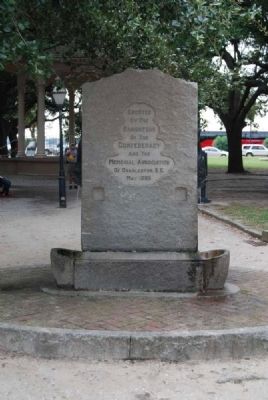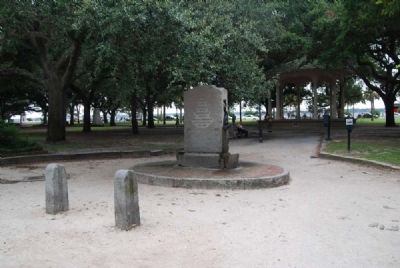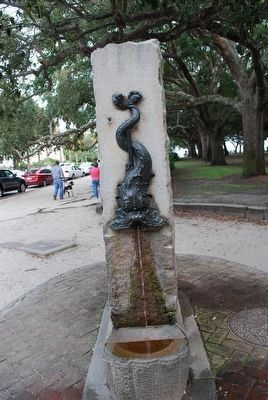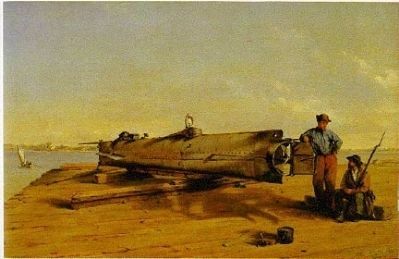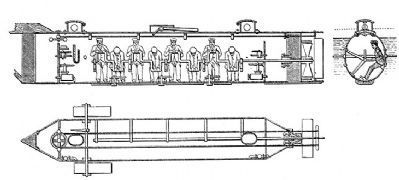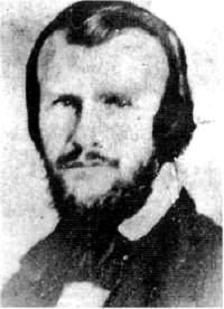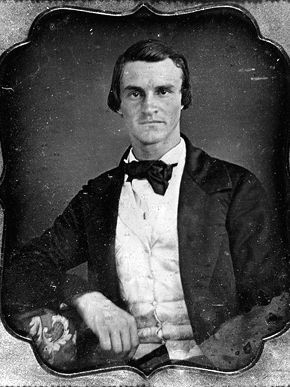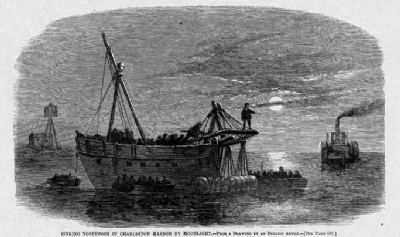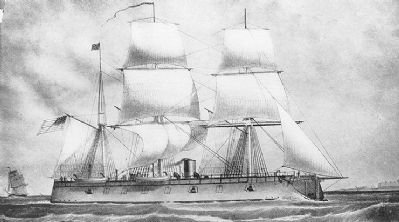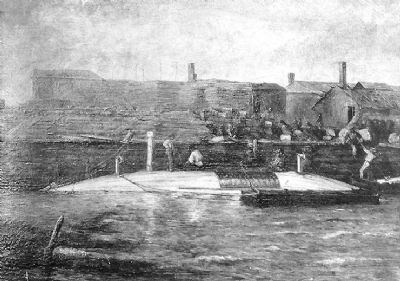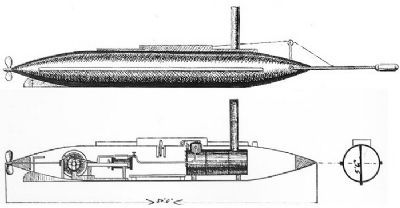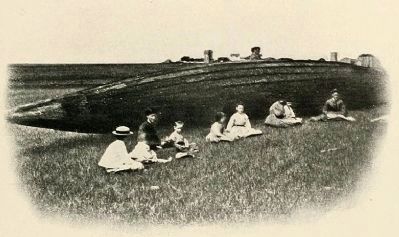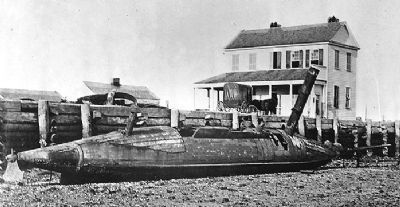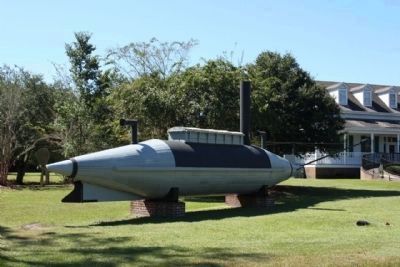South of Broad in Charleston in Charleston County, South Carolina — The American South (South Atlantic)
Civil War Torpedo Boatmen Memorial
Inscription.
The Supreme Devotion of Those Heroic Men
Of the Confederate Army and Navy
First in Marine Warfare
To Employ Torpedo Board
1863 - 1865
Moved by
The Lofty Faith That With Them Died
Crew After Crew
Volunteered
For Enterprises of Extremest Peril
In the Defenses of Charleston Harbor
—————
Of More than Thirty Men
Drowned in this Desperate Service
The Names of but Sixteen are Known
Lost in Charleston Harbor
15 October 1863
Inventor of Submarine Boat
Sinking Blockader Housatonic
17 February 1864
Lieut. 21st Alabama Vols.
Corporal Wagener Arty.
—————
Attacks Without Loss of Life
Blockader New Ironsides 5 October 1863, by the Little David designed by St. Julien Ravenel, M.D. Commanded by Lieutenant W.T. Glassell, Confederate States Navy.
Erected 1899 by Charleston Chapter, United Daughters of the Confederacy, and the Memorial Association of Charleston, S.C.
Topics and series. This historical marker and memorial is listed in this topic list: War, US Civil. In addition, it is included in the United Daughters of the Confederacy series list. A significant historical date for this entry is February 17, 1864.
Location. 32° 46.2′ N, 79° 55.8′ W. Marker is in Charleston, South Carolina, in Charleston County. It is in South of Broad. Marker is at the intersection of South Battery and Meeting Street, on the right when traveling west on South Battery. Located in White Point Garden. Touch for map. Marker is in this post office area: Charleston SC 29401, United States of America. Touch for directions.
Other nearby markers. At least 10 other markers are within walking distance of this marker. Stede Bonnet / Richard Worley (within shouting distance of this marker); Thirteen - Inch Mortar (within shouting distance of this marker); Thirteen Inch Mortar (within shouting distance of this marker); William Gilmore Simms (within shouting distance of this marker); a different marker also named Thirteen - Inch Mortar (within shouting distance of this marker); To the Defenders of Fort Moultrie
(about 300 feet away, measured in a direct line); The Salvaging of this Gun (about 300 feet away); a different marker also named Thirteen - Inch Mortar (about 300 feet away); Ten - Inch Smooth Bore Columbaid Cannon (about 400 feet away); Eleven - Inch Dahlgren Gun (about 400 feet away). Touch for a list and map of all markers in Charleston.
More about this memorial. This is the oldest monument in Charleston to mention the Hunley and her crew.
Also see . . .
1. Torpedo > Early Naval Torpedoes. During the American Civil War, the term torpedo was used for what is today called a contact mine, floating on or below the water surface using an air-filled demijohn or similar flotation device. (Submitted on September 24, 2011, by Brian Scott of Anderson, South Carolina.)
2. Torpedo Boat > American Civil War. The American Civil War saw a number of innovations in naval warfare, including the first torpedo boats, which carried spar torpedoes. (Submitted on December 16, 2011, by Brian Scott of Anderson, South Carolina.)
3. CSS H.L. Hunley. H.L. Hunley was a submarine of the Confederate States
of America that played a small part in the American Civil War, but a large role in the history of naval warfare. (Submitted on December 16, 2011, by Brian Scott of Anderson, South Carolina.)
4. Horace Lawson Hunley. Horace Lawson Hunley (June 20, 1823, Sumner County, Tennessee – October 15, 1863, Charleston, South Carolina), was a Confederate marine engineer during the American Civil War. (Submitted on September 24, 2011, by Brian Scott of Anderson, South Carolina.)
5. Seaman Robert Brookbank. Seaman of the submarine H.L. Hunley on it's second attempt to attack the Union Blockade. (Submitted on December 17, 2011, by Brian Scott of Anderson, South Carolina.)
6. Seaman James Patterson. Seaman of the submarine H.L. Hunley on it's second attempt to attack the Union Blockade. (Submitted on December 17, 2011, by Brian Scott of Anderson, South Carolina.)
7. Seaman Henry Beard. He was a seaman of the submarine H.L. Hunley on it's second attempt to attack the Union Blockade. (Submitted on December 17, 2011, by Brian Scott of Anderson, South Carolina.)
8. Seaman John Marshall. Seaman of the submarine H.L. Hunley on it's second attempt to attack the Union Blockade. (Submitted on December 17, 2011, by Brian Scott of Anderson, South Carolina.)
9. Seaman Charles L. Sprague. Seaman of the submarine H.L. Hunley on it's second attempt
to attack the Union Blockade. (Submitted on December 17, 2011, by Brian Scott of Anderson, South Carolina.)
10. George E. Dixon. George E. Dixon (1837? - February 17, 1864) was a first lieutenant in the Confederate Army in the American Civil War. (Submitted on December 17, 2011, by Brian Scott of Anderson, South Carolina.)
11. USS Housatonic. The first USS Housatonic was a screw sloop-of-war of the United States Navy, named for the Housatonic River of New England which rises in Berkshire County, Massachusetts, and flows southward into Connecticut before emptying into Long Island Sound a little east of Bridgeport, Connecticut. (Submitted on September 24, 2011, by Brian Scott of Anderson, South Carolina.)
12. USS New Ironsides. USS New Ironsides was a wooden-hulled broadside ironclad built for the United States Navy during the American Civil War. (Submitted on September 24, 2011, by Brian Scott of Anderson, South Carolina.)
13. CSS David. CSS David was a Civil War-era torpedo boat built as a private venture by T. Stoney at Charleston, South Carolina in 1863, and put under the control of the Confederate States Navy. (Submitted on December 16, 2011, by Brian Scott of Anderson, South Carolina.)
14. Confederate States Navy. The Confederate States Navy (CSN) was the naval branch of the Confederate States armed forces established by an act of the Confederate Congress on February 21, 1861. (Submitted on December 16, 2011, by Brian Scott of Anderson, South Carolina.)
Additional commentary.
1. Torpedo Boatmen Memorial
The Memorial Association of Charleston and the U.D.C. of Charleston raised $1,000 to pay for this seven-foot-tall granite marker and unveiled it in May of 1899. E.T. Viett sculpted what was originally a drinking fountain with water flowing from the two bronze dolphins. The Charleston City Year Book of 1907 said, "Perhaps no operations of any description during the entire struggle made a greater demand upon the courage of those who participated in them, than did the series of attempts made, with these little craft, to destroy the federal blockading fleet on the southern coast."
The Confederate Navy employed at least three types of torpedo boats in Charleston Harbor. The Torch had its origins in a March 1863 design by Captain Francis D. Lee. This craft was a twenty-foot open canoe. It was oar-powered and carried a twenty-two-foot spar with a thirty-pound charge of powder. When a failed attack on the Powhatten in the summer of 1863 by Commander W.T. Glassell in the Torch made it clear that steam power was needed. Lee made the changes by renovating the hull of a torpedo ram. The Torch, under the command of Captain James Carlin, with Lt. E.S. Flickling and a crew of eleven, attached the U.S.S. New Ironsides near Morris Island on August 21, 1863. Its spar, however, became entangled in the New Ironsides' anchor chain, and Carlin aborted the attack, having been spotted by the Ironsides' sentry. The Torch was not used again.
Charlestonian St. Julien Ravenel, an inventive genius, designed the torpedo-spar David, and Charlestonian Theodore D. Stoney gave $20,000 for its construction. It was built at the Stoney Landing on the Cooper River in 1863. The David was a wooden, cigar-shaped craft, twenty-feet lone with a five-foot beam. She had a draft of six-and-a-half feet with ten inches of deck exposed above the surface. She carried 100 pounds of rifle powder on the tip of a fourteen-foot steel spar. The helmsman sat on the deck and steered with his feet. The David attacked the New Ironsides on October 5, 1863, with a volunteer crew of four: Lt. W.D. Glassel; J.H. Tomb, chief engineer; James Sullivan, fireman of the gunboat Chicora; and J.W. Cannon, assistant pilot of the gunboat Palmetto State. The David left the South Atlantic Wharf between 6:00 and 7:00 p.m. under a dark, hazy sky and proceeded down the harbor. A sentry on board the Ironsides spotted the boat when it was 300 yards away. After closing to forty yards, Glassel fired his shotgun at the officer on the deck, inflicting a mortal wound. The torpedo struck the starboard side of the New Ironsides six feet below the surface and exploded. An immense volume of water was thrown up, entering the David's smokestack, and extinguished the fire in the furnace. Under heavy fire from the New Ironsides, Glassel ordered all hands overboard. A Federal boat Glassel, and Sullivan swam to the boat, and Tomb returned to it after a short swim. Cannon and Tomb refired the furnace and escaped safely back to Charleston. This was the first time a steam torpedo boat had made a successful attack on an enemy vessel. The New Ironsides was repaired and continued to participate in the blockade of Charleston. On March 6, 1864, the David attacked the gunboat Memphis in the North Edisto River, and on April 18, 1864, it attacked the Wabash in Charleston Harbor. Both attacks were unsuccessful.
The design of the first vessel of the era to operate completely submerged grew from experiments conducted in New Orleans in 1862 by James R. McClintock and Baxter Wilson and financed by Horace Lawson Hunley, a local lawyer, legislator, and cotton
merchant. After the fall of New Orleans, Hunley, McClintock, and Lt. George F. Dixon continued their work in Mobile, Alabama. Their prototype, the American Diver, sank in Mobile Bay without loss of life in 1862. The group went on to design another submarine, this one, popularly known as the "fish torpedo boat," was officially designated the C.S.S. H.L. Hunley. It was constructed in 1863 in Mobile from a galvanized iron boiler cut in half and was thirty feet long. It had a four-foot beam and five feet of head room. From a sitting position, the eight-men crew worked hand cranks to turn the propeller. The pilot operated the external fins and rudder, which allowed the boat to rise or sink with forward motion. Fore and aft tanks worked by hand pumps provided ballast. The torpedo was originally carried in tow at the end of a 200-foot line, the idea being that the boat would dive under its target and tow the torpedo into the target's hull. Later, this method of delivery was replaced by Francis D. Lee's forward-facing spar, which carried the powder charge on its tip.
— Submitted January 29, 2012, by Brian Scott of Anderson, South Carolina.
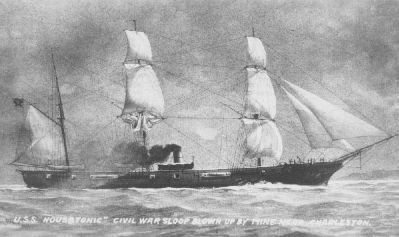
United States Navy
11. USS Housatonic
Housatonic was the first ship in history to be sunk by a submarine, the CSS H.L. Hunley.
Click for more information.
Click for more information.
Credits. This page was last revised on February 16, 2023. It was originally submitted on September 24, 2011, by Brian Scott of Anderson, South Carolina. This page has been viewed 2,260 times since then and 103 times this year. Photos: 1, 2, 3, 4. submitted on September 24, 2011, by Brian Scott of Anderson, South Carolina. 5. submitted on August 14, 2015, by Brandon Fletcher of Chattanooga, Tennessee. 6. submitted on January 29, 2012, by Brian Scott of Anderson, South Carolina. 7, 8. submitted on December 16, 2011, by Brian Scott of Anderson, South Carolina. 9. submitted on January 29, 2012, by Brian Scott of Anderson, South Carolina. 10, 11, 12. submitted on September 24, 2011, by Brian Scott of Anderson, South Carolina. 13, 14, 15, 16. submitted on December 16, 2011, by Brian Scott of Anderson, South Carolina. 17. submitted on February 2, 2012, by Mike Stroud of Bluffton, South Carolina.
